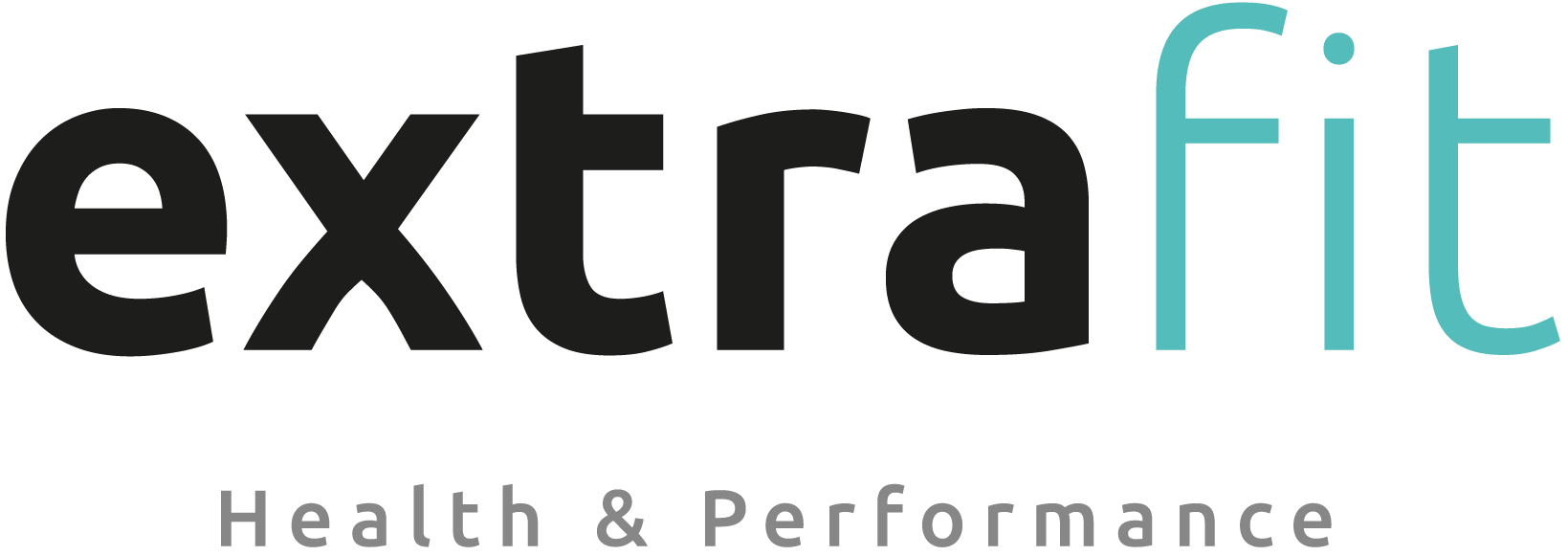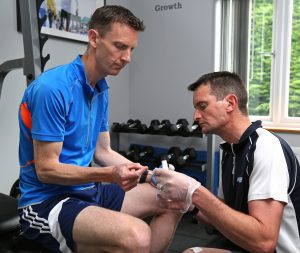Our blog provides a thorough overview of Tim’s training plan pre, during and post event, as such feel free to jump to each section by clicking the headings linked below.
- When I get asked why!
- How do you put together a training plan for an endurance event?
- How intense does training need to be? Testing time!
- Banking the hours over the months
- Nutritional Thoughts on Training & Race Day
- Quantifying improvement – A mid-June test to measure progress.
- Race Day! CX Century: South Downs 100-mile MTB ride in 2022
When I get asked why!
I have always relished a physical challenge and have a reasonable background as an endurance athlete. In the early 2000’s I ran some sub-3hr marathons and thoroughly enjoyed training regularly trying to be the best I could. This enjoyment of running was cut short in 2013 when I was diagnosed with a chronic left hip injury. Whilst not debilitating, all the sensible advice from orthopaedic surgeons suggested giving up running and prolonging the life of the joint prior to inevitable hip replacement one day. I guess looking back, it hit me harder than I realised or admitted. The one thing I was good at and took huge satisfaction and pride from was taken away from me. Roll nearly 10 years on and an ongoing career in fitness meant I was always active to a reasonable level but never regularly training myself with any purpose although family life with two young boys was always active. Cycling had become a favoured pastime, a means to get some fresh air in the Hampshire hills and get the heart pumping.
In January 2022, after maybe more than one glass of wine(!), I stumbled across an advert for a mountain bike event involving cycling the South Downs Way from beginning to end in a day – Winchester to Eastbourne – 100 miles of rough terrain and endless hills. I loved the sound of the challenge, and it was something to give a focus. I woke up the next morning to an email confirming that I had entered the race! I had six months to train; this was going to be a big challenge.
The following blog chronicles my training and preparation for the event…
How do you put together a training plan for an endurance event?
Some of the motivation behind the challenge was to practice what I preach. As part of my work within fitness, I offer cardiopulmonary exercise testing (CPET) with runners, cyclists, and triathletes, helping them to understand their physiology better, equipping them with the right information to train in the most effective way to achieve their personal best.
In recent times, sports scientists have grappled with different training methodologies arguing over intensity distribution – how hard does training need to be and how much do you need to do? We have the 80/20 Polarised approach made popular by research by Dr. Stephen Seiler whilst others refer to a pyramidal approach. The one thing that tends to be common between the approaches is the need to do a large proportion of your training at a relatively low intensity relative to maximal.
These intensities are often referred to as Zones and the one thing most endurance athletes come to my clinic for is to discover their personal hallowed Zone 1 & 2 heart rate, pace, and power outputs. Zone 2 is key; it is at this intensity we know where huge benefits can be gained without amassing significant levels of strain and fatigue. It is often classified as the intensity just prior to a level where blood lactate starts to accumulate, a sign of increased fatigue. It is also an intensity in theory where fat should be a significant contributor to fuelling the work, sparing the precious carbohydrate stores in the muscles and liver.
With a young family, a busy life and a small business to run I was aware I needed to be flexible in my training. My plan was simple, aim to train 3 maybe 4 times per week and follow the 80/20 approach. This recommends accumulating 80 percent of your training time in Zone 2 and below, whilst just 20% is performed at the higher leg-burning intensities. I would start aiming to total around 3 hours per week and steadily increase this where possible. Long rides (2-3hrs) would be very occasional initially but in the 8 weeks prior to the event I would ensure that 4 or 5 long rides were completed ranging between 5 and 8 hours long. These would be key for endurance building, confidence but also vital to rehearse nutrition and hydration.
How intense does training need to be? Testing time!
Being very fortunate to have a metabolic cart and lactate testing equipment, it was time to test myself. By completing a Lactate Profile & V̇O2Max test, I would establish the key training zones upon which my training would be based. The test would also give me a benchmark of my present fitness level and my present ability to burn fat as a fuel at progressively increasing intensities. One of the key differences between the good athletes and the best ones is the ability to still use fat as a fuel at high intensities, we have a very limited supply of carbohydrates stored in our body and even the leanest individuals have plenty of fat stores to fuel work. Being a better fat burner makes everything better!
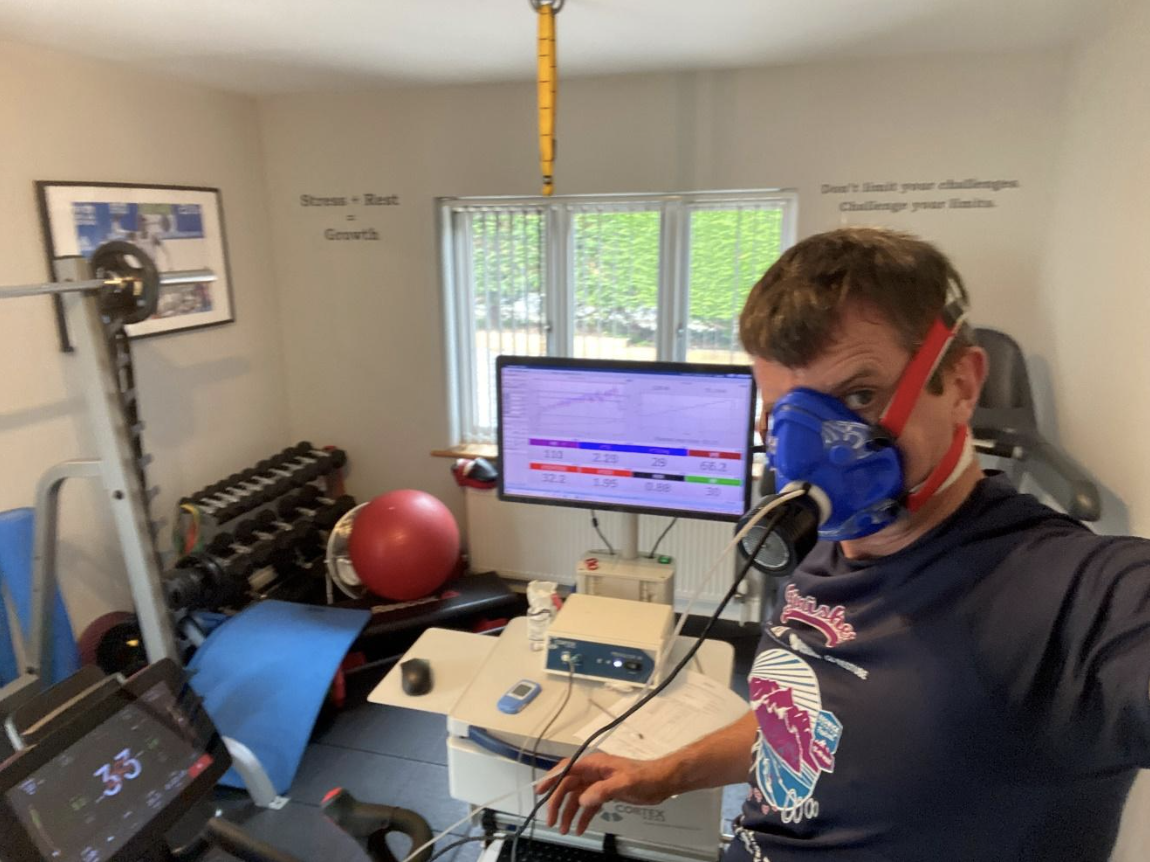
After 2 weeks of light training just to get moving, on 16th January I got set up and put myself through a gruelling test! The table below show the key results and resultant training zones.

After 2 weeks of light training just to get moving, on 16th January I got set up and put myself through a gruelling test! The table below show the key results and resultant training zones.
Training Zone Data

Banking the hours over the months
With the test completed and intensity zones established, I set about training consistently as the weeks ticked by. Monday nights were always good, my wife was out and the kids were in bed so I would always do 60-90mins on the indoor Wattbike trainer. Lots of 0515 alarm calls occurred, again for 45-60mins on the trainer before work. Aside from this, inevitably with a busy life, sessions just had to be grabbed when possible around kids and work commitments. Nearer the race I planned appropriate weekends where long rides would happen, some of these starting very early and using most of the day. Consistency was key and somehow, I managed to bank the hours each week. Managing my hip injury, I was sensible and very rarely trained on concurrent days, making sure I recovered and didn’t over train.
From my lactate profile test, I knew that as soon as my heart rate goes much above 133bpm I am leaving Zone 2 and starting to overdo it. I lived by this and countless sessions I adjusted the intensity to keep within the boundary. HIIT type sessions did occur occasionally, maybe 1/week. Often either lots of 40-60s all out efforts with short 20-30s recoveries or maybe 4 x 8mins at the tough Zone 4 power and heart rate.
The longer rides out on the mountain bike were a pleasure. I am fortunate to live 30 minutes pedal away from the South Downs Way, so often I was able to ‘recce’ the race route itself locally, other times I drove further east to allow for an exploration on the further end of the route towards Eastbourne. The main thing I was struck by is just how rough and how hilly the route is. I had always thought the SDW was an undulating bridleway track, in very few sections it is but mostly it is chalky rutted steep relentless hills. I was pleased I had ridden all but the last 14miles of the route in training come race day but also daunted by what was ahead, attempting to do the entire distance in one day.
The picture below shows the Performance Management Chart from the excellent Training Peaks software I use for coaching Extrafit clients. Each red do is a workout, and the shaded area shows fitness building as the months go by. In the 6 months training for the event, I spent close to 177 hours cycling preparing for the event, logging 2456miles. The pie chart shows the breakdown of all this training by intensity, achieving as planned with 78% in Zone 2, 22% in Zone 3,4 & 5.
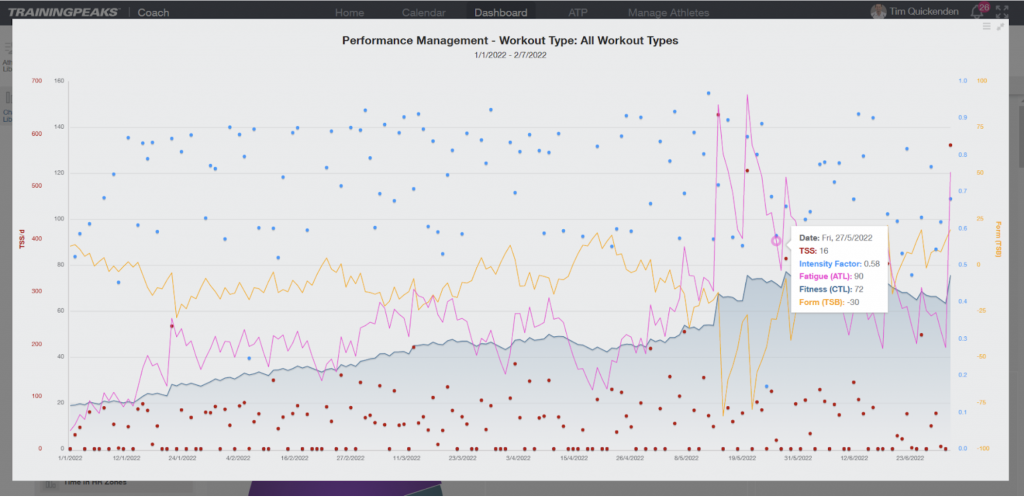
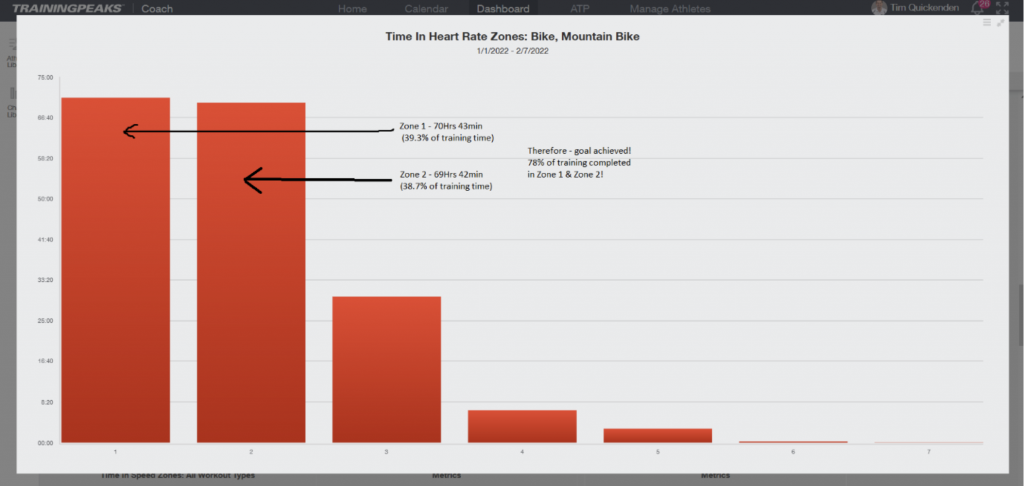
Nutritional Thoughts on Training & Race Day
You could write a whole separate blog about a personalised approach to nutrition whilst training for an event like this. I am fortunate that I don’t have a sweet tooth and as a family we enjoy cooking and eating mostly healthy, nutritious home cooked food. Real food is always chosen over supplements though occasional protein recovery shakes would be consumed after particularly long rides or tough sessions. Food should be savoured and enjoyed but it should always also be viewed as fuel. Adjusting calorie intake and especially carbohydrate intake depending on just how much you have moved on any given day is a key approach.
Protein however is non-negotiable, the vital food group that allows our muscles to recover and develop cannot be stored in the body so it is vital to get a reasonable amount daily, at around 75Kg bodyweight, I would aim to consume around 120-150g per day (1.6-2.0g/Kg bodyweight). This would come from mainly chicken, fish and dairy as well as occasional red meat.
When training to beat marathon PBs and alike in the past, I have always had the tradition of giving up alcohol for around 8 weeks prior to the event. As much as I enjoy a few beers and the occasional glass of wine, abstinence is always quite interesting. The most interesting benefit is improved sleep quality as well as reduction of excess ‘empty’ calories. For this event I abstained for just over 4 months and again am pretty sure this had a marked effect on training quality, recovery and performance improvement.
A key area I have worked so much on with endurance clients over the years is fuelling whilst training to allow for easier consumption whilst racing. In any event lasting around 2 hours or more you will inevitably run out of muscle and liver glycogen stores (carbohydrates). Without a proper plan to feed and replenish this, things will always get ugly come race day. Sports science tells us that the body can digest and absorb around 60-90g of carbohydrate per hour whilst exercising. I was going to make sure I developed this ability to the maximum. Fortunately, it is easier to eat whilst cycling compared to running. I would set out on training rides with a jersey stuffed full of small rolls with cheese or tuna, Chia Charge muesli bars and SIS Gels. The target would be to have something to eat every 20mins – a bite of a roll, a large bite of a cereal bar, whatever it took to keep drip feeding energy into the body. On reflection, this was probably the most important factor in success come race day.
During the race I took the same approach. Being fortunate to be ‘crewed’ by my wife and kids, they rendezvoused with me around every 20 miles to replenish food stores and refill energy drink and water bottles. I stuck to my plan of eating every 20 minutes, in the later stages of the race a few ice cold cans of coke were consumed and just to mix up the flavours, I had a treat of a cheeky Pepperami and some salt and vinegar Pringles.
Quantifying improvement – A mid-June test to measure progress.
Having tested myself to establish training zones back in January, in mid-June, two weeks before the race I put myself through the same step test on the metabolic cart and Wattbike. The performance improvement was astonishing. As someone who works with endurance athletes extensively in this area, I was delighted that my ‘n=1’ case study showed such significant gains. My lactate thresholds had improved considerably but the most significant and useful change was the improvement in the ability of my body to use fat as a fuel. The graph below shows this. It can be seen that in January, above 100W power output, my body was entirely dependent on carbohydrates to fuel exercise. As discussed in the nutrition section, we only have a finite store of those so I would run out of energy fast! Conversely, as the graph shows for June, right though to a high power output of 240/260W, my body was still able to mobilise fat stores to provide energy.
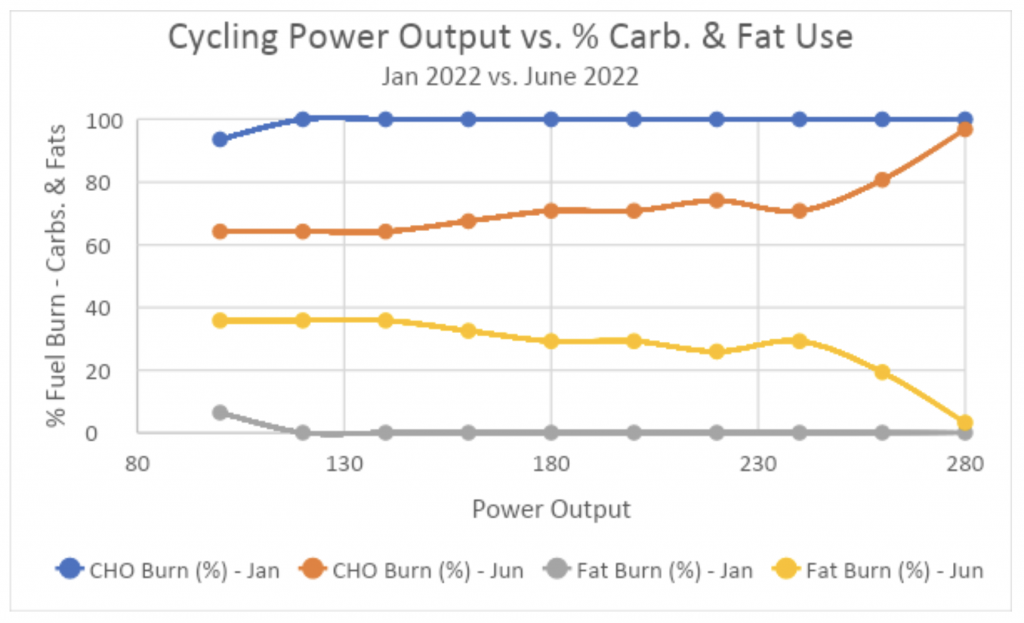
Other marked improvement could be seen in heart rate at different sub maximal intensities. The lower the heart rate, the better the body is coping with the strain of maintaining the power output. The graph below shows this improvement well. Through testing I know that my maximum heart rate on the bike (HRmax) is 182 bpm. The data line on the graph for the June test shows just how much easier each intensity was maintained. The differences may not look huge, but they are significant. My aerobic threshold (LT1) is around 200/220W), this is the most likely power output I would ride at over the course of the 10-12 hours of the race. The differences at this level are significant and useful from an energy expenditure point of view.

In hindsight, I should have conducted a test around March/April time mid-way through the training process. Although the 6-month training process was successful, I would imagine my heart rate zones would have changed a fair bit, maybe allowing me to train better in the final few months before the race.
Race Day! CX Century: South Downs 100-mile MTB ride in 2022
So finally, Saturday 2nd July arrived. A 4.00am alarm was set, my bike was checked over and saddle and top tube bags packed full of basic tools, inner tubes and energy bars and gels. The logistics for the race were complicated, it being a ‘point-to-point’ race. I would drive to Winchester in my van for the start at 6.30am, my wife and kids would then ‘crew’ me at around the 20/40/60/80-mile points eventually (fingers crossed) meeting me at the finish on top of Beachy Head near Eastbourne. They would then drive me back home and we would worry about collecting my van the next day.
Fortunately, I slept well and got over to the start in good time following a substantial breakfast of Weetabix, bananas, eggs, and coffee. The nervous anticipation at the start was incredible. I was struck by how many riders were there, estimating around 200 in the car park preparing for the challenge. It was a glorious bright morning though concerningly felt like a day that could get hot – not ideal but nothing could be done about it. As usual, the queues for the loos were massive, but fully registered we finally lined up ready for the start.
Anticipating the course would take me between 10 and 12 hours, the only option was to settle into a steady comfortable pace and not get carried away by the occasion, eat something every twenty minutes, keep drinking both energy drink and water throughout and with the anticipated hot temperatures, I also took 1 ‘S-Cap’ salt tablet each hour to offset mineral losses in sweat.
The early miles, in fact the first half of the race, were a joy. A glorious day, stunning scenery up on the Downs and plenty of good company occasionally chatting with other riders as we shared the challenge of ascending and descending some challenging hills. I felt good and was sticking to my nutrition plan perfectly. Meeting my family at occasional points where the route crossed major roads was also a huge energetic and morale lift. A lovely surprise was a close friend and fellow endurance race fan Al had made the trip down from Essex to support too. Each stop for food and fluid replenishment was no more than a minute or two but spirits were lifted as I set out on the next leg.
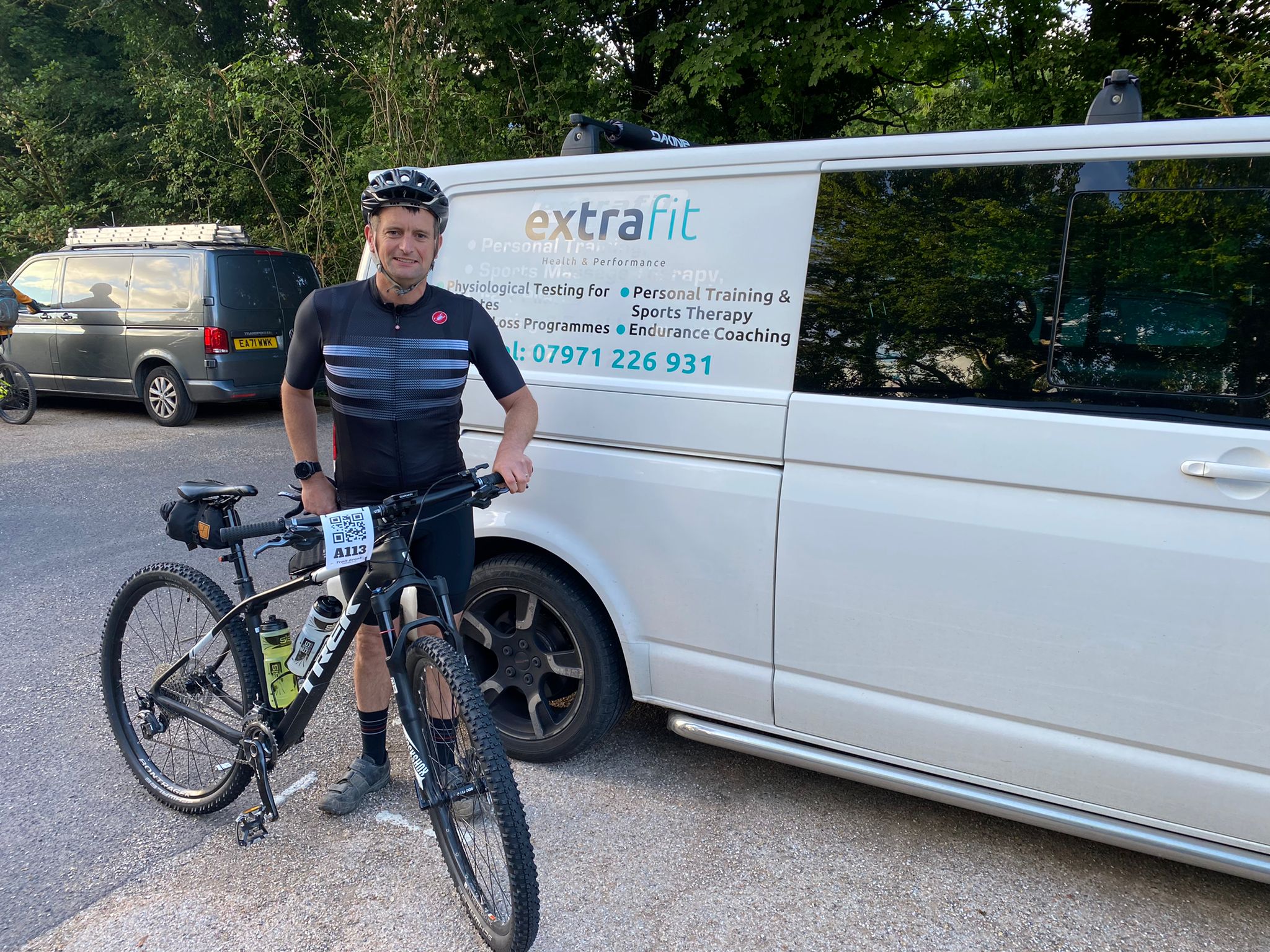
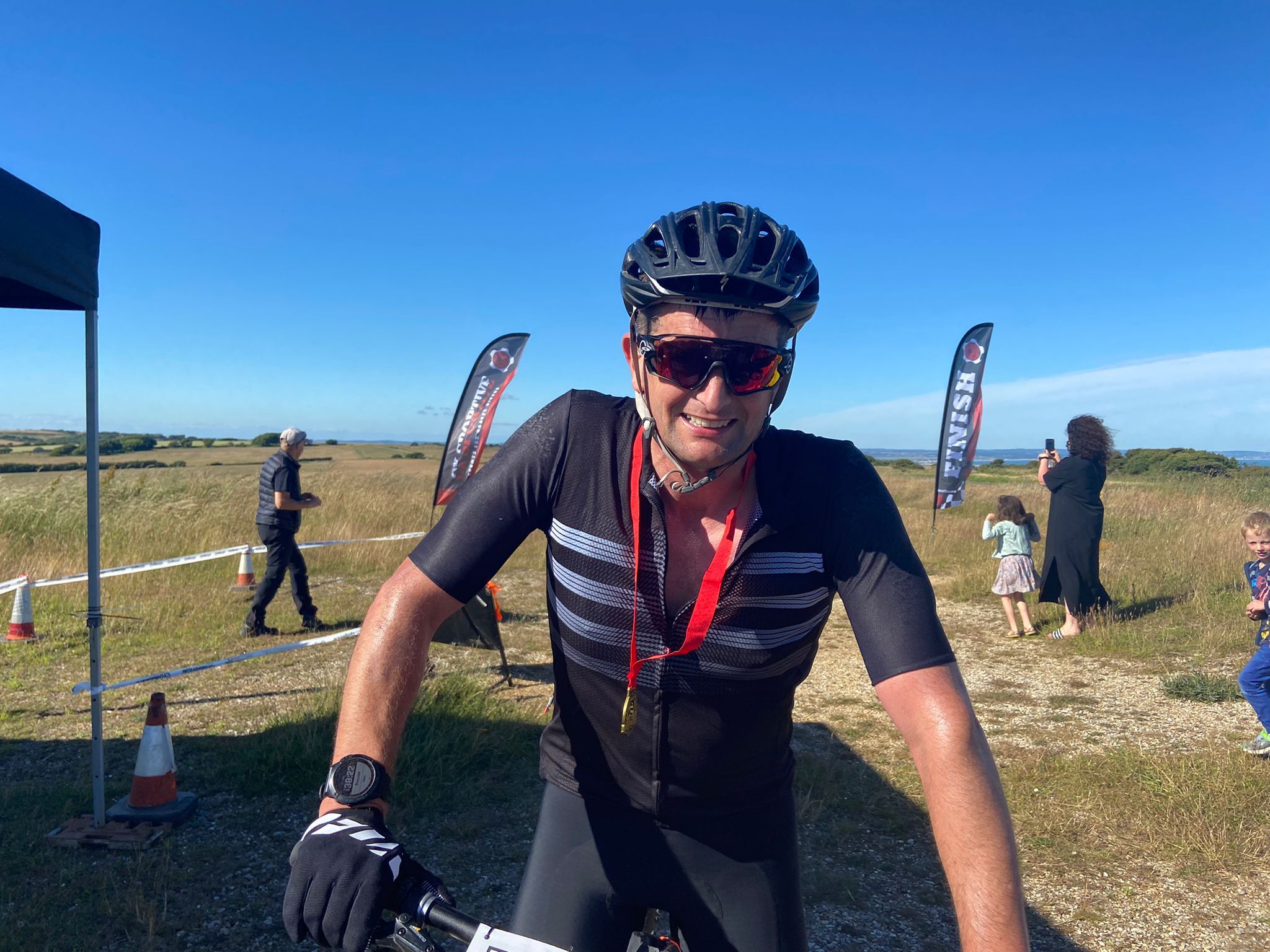
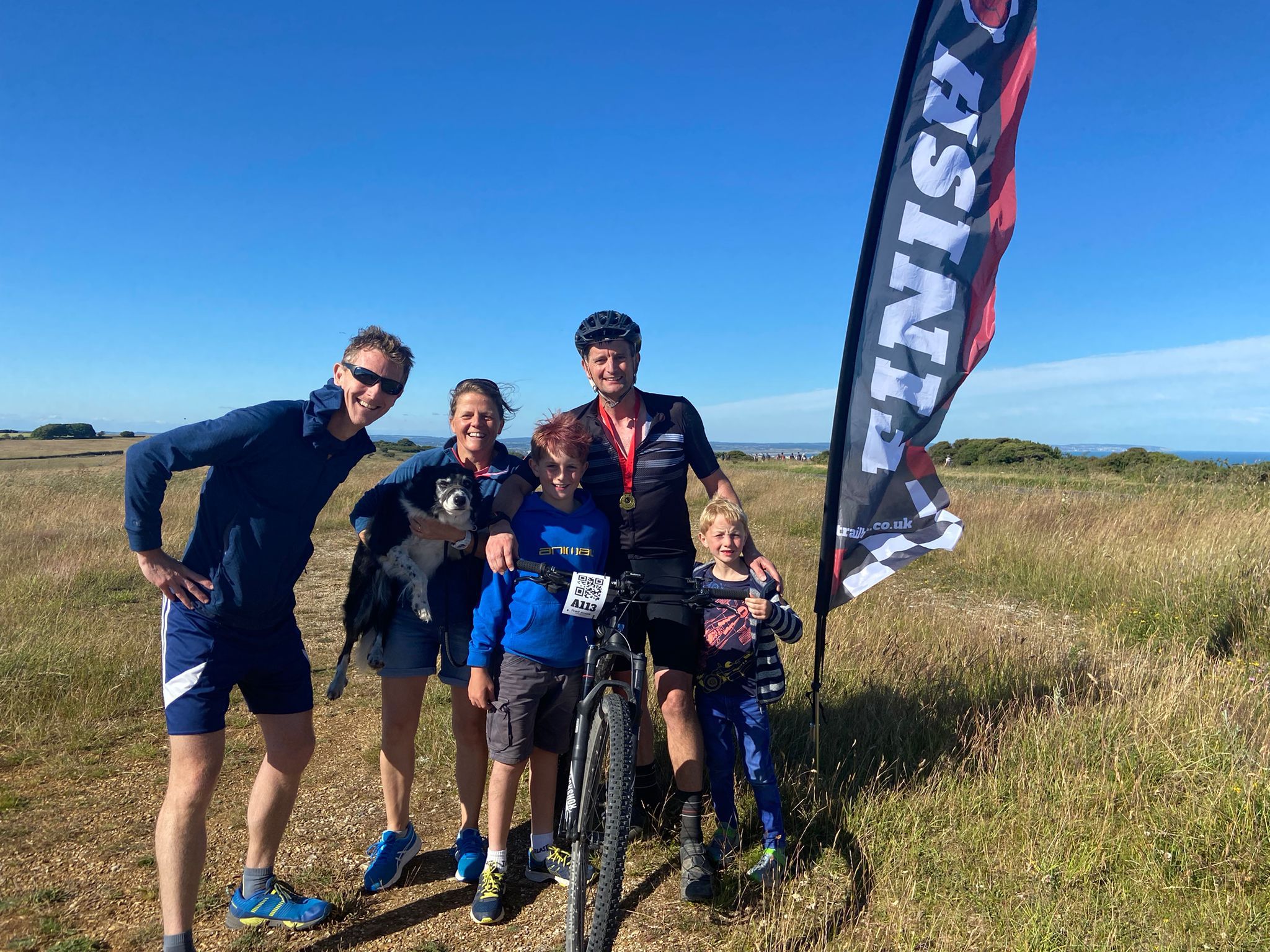
Some people maintain the hills over the course of the South Downs way are spread evenly across the 100-mile route – it didn’t feel that way to me. I am sure it is partly down to developing fatigue but from the 50mile point onwards things seemed to get really tough, some of the climbs in the section between 50 and 80miles are brutal and long, however, I just kept turning my legs, eating regularly and slowly munched through the miles. For a few hours I rode with two other guys who had ridden the race before. They were good company, and we were at a similar speed. Their input was useful in the final miles in the section where I hadn’t managed to ride in training.
Having completed the last big climb out of Alfriston, in the final few miles up onto Beachy Head it dawned on me I had done it! I had achieved my goal. My legs actually felt great, they had just kept turning all day, yes of course some of the hills got them burning but I recovered well from each one and just seemed to be able to keep going. It was the other parts of my body that were suffering, really suffering in fact. The inevitable saddle sore was painful, but I was struck most by how much my wrists, triceps, neck and upper back muscles were shredded. I wanted to get off the bike to relieve those rather than my legs.
The atmosphere at the finish was great. I finished in a time of 10hrs 31minutes and it was lovely to be cheered under the finish banner by my wife Jo, my sons and friend Al. As ever, getting changed and taking the bike apart to load into the car whilst the body slowly seized up was hilarious and painful at the same time. In these moments, the sense of elation and accomplishment, high on endorphins is intoxicating and enjoyable. Time was going to be needed to recover from this, the body the following day was really sore, but again not the legs so much but everything else. What will the next challenge be? Family and work commitments always have to be factored in but I am sure some other crazy event will come along that will pique my interest…
Feel free to discuss your events, or any you’d recommend I try.
